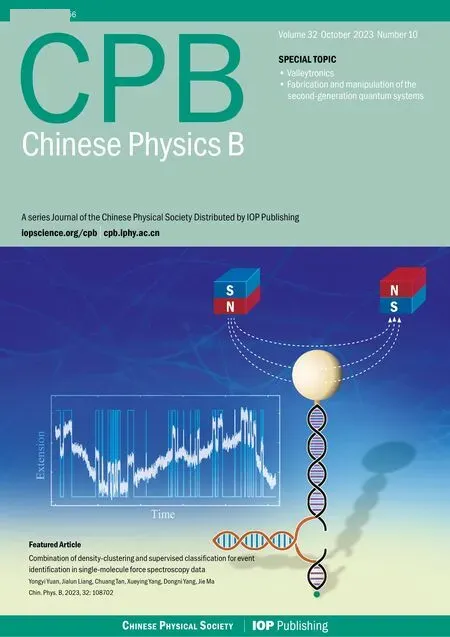Lifetime measurement of the 3d92D3/2 metastable level in Mo15+at an electron beam ion trap
Jialin Liu(劉佳林),Yintao Wang(王銀濤),Bingsheng Tu(屠秉晟), Liangyu Huang(黃良玉), Ran Si(司然),Jiguang Li(李冀光), Mingwu Zhang(張明武), Yunqing Fu(傅云清), Yaming Zou(鄒亞明), and Ke Yao(姚科),§
1Shanghai EBIT laboratory,and Key Laboratory of Nuclear Physics and Ion-Beam Application(MOE),Institute of Modern Physics,Fudan University,Shanghai 200433,China
2Institute of Applied Physics and Computational Mathematics,Beijing 100088,China
3Institute of Modern Physics,Chinese Academy of Sciences,Lanzhou 730000,China
Keywords: lifetime measurement,molybdenum ions,metastable levels,electron beam ion trap(EBIT)
1.Introduction
Forbidden transitions have been captive substantial interest across various fields.[1-4]Precision measurements of forbidden transitions have multiple applications,including probing fundamental physics,[5-10]developing frequency-standard metrology,[11-14]and searching for new physics beyond the standard models.[15]Moreover, these forbidden lines contribute significantly to diagnosing laboratory and astrophysical plasmas,[1,16-20]since their intensities tend to be sensitive to the density or temperature of the plasma.
Transition energies and lifetimes are the fundamental observables of the forbidden transitions.Accurate measurements of energies and lifetimes particularly for highly charged ions(HCIs), play an important role in testingab initioatomicstructure calculations of quantum many-body systems.Regarding an atomic system with a vacancy in a closed shell(e.g.,2s22p5and 3d9), many accurate theoretical predictions[21-25]and measurements[26-29]have been performed during the past few years.Due to the inherent simplicity of these systems which implies a small correlation contribution, their level structures can be calculated to high precision allowing for the testing of higher-order quantum electrodynamics effects in many-body atomic systems.For instance, various atomic-structure calculation methods[21-23]have been employed to investigate the transition properties of ground-state fine-structure line (3d92D3/2-2D5/2) in highly charged Colike ions.However,to the best of our knowledge,there are no available measurements of the transition probability (inverse of lifetime)of the 3d92D3/2-2D5/2transition.
In this work,we presented experimental details of a lifetime measurement of the Mo15+3d92D3/2metastable level using an electron beam ion trap (EBIT).The measurement was carried out by monitoring the temporal decay of optical fluorescence from the magnetic dipole(M1)3d92D3/2-2D5/2transition with a wavelength ofλ=370.81 nm.[30]Dedicated efforts were especially devoted to assessing the systematic effects,and the radiative lifetime of the 3d92D3/2level in Mo15+was determined to be 2.83(22)ms.
2.Experimental method
The measurement is performed at the Shanghai EBIT laboratory using a room-temperature permanent-magnet EBIT with a magnetic field strength of 0.65 T.The experimental setup has been introduced in the previous publication in detail,[2]and thus only the essentials of the lifetime measurement procedures(depicted in Fig.1)are outlined in the subsequent section.
In an EBIT, highly charged ions were produced through electron impact ionization.To produce Mo ions, a molecular beam of molybdenum hexacarbonyl, Mo(CO)6, was injected into the trap region with a gas injection system and then it was fragmented and ionized through the collisions with the electron beam emitted from the thermionic cathode.The electron beam energy was set to 400 eV for charge breeding.Typically,Mo15+ions could be created in the center drift tube after an elapsed time of several hundreds of ms.In this configuration,the axial confinement was provided by the electrostatic potential,while the radial confinement arises from a combing effect of the magnetic field and the electron beam space charge.Furthermore, to suppress charge exchange processes due to the collisions with the residual gas atoms in the trap,the pressure of the gas injection system was kept constant at a low level of 5.6×10-8torr in the whole lifetime measurement campaign.
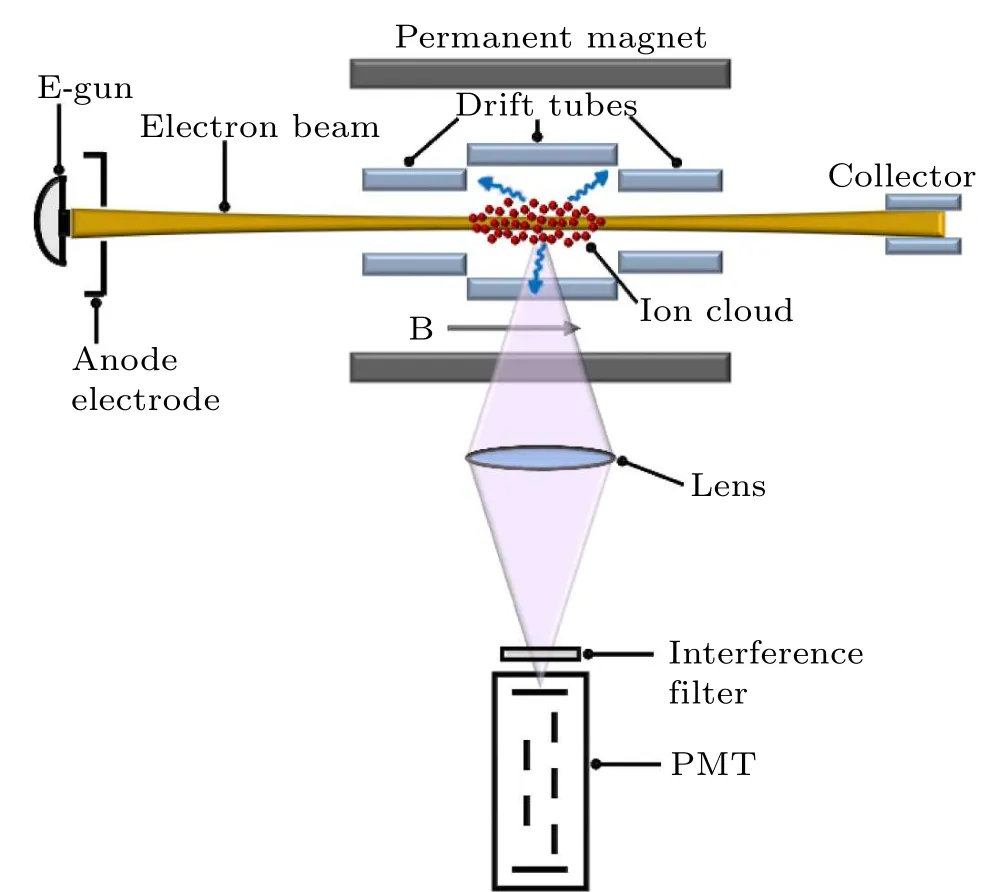
Fig.1.Schematic drawing of the experimental setup.
In the EBIT, the trapped ions undergo continuous collisions with the energetic electrons, thereby exciting them to their excited states,resulting in photon emissions after the excitation.The radiations are focused by a set of lenses onto a cooled photomultiplier tube(PMT).The PMT detection could be significantly influenced by stray light,which is mainly generated by the glowing of the thermionic cathode(T ≈1600 K).During the measurement, the heating current of the cathode filament is intentionally reduced to minimize the stray light effect.Apart from this, since the transition wavelength of2D3/2-2D5/2is 370.81 nm,[30]a narrow band interference filter, with a central wavelength of 370 nm (bandpass 10 nm,peak transmission of approximately 80%),is installed in front of the PMT,such that the light with other wavelength could be strongly suppressed.This way, the background count rate of PMT is reduced to around 1400 s-1,which is the main limitation of the measurement precision.
In order to measure the decay of optical fluorescence from the M1 3d92D3/2-2D5/2transition, it is necessary to interrupt the electron beam, via a mode referred to as magnetic trapping.[31]The measurement scheme involves a beam-on time of 1900 ms followed by a beam-off time of 100 ms.In total, this cycle is repeated for more than tens of thousands of times to ensure statistical significance.Every 10th cycle,the trap is dumped to eliminate heavy ion contaminants,such as lanthanum,which originates from the electron cathode and could occupy a significant portion of the trap region.
3.Results and discussion
3.1.Decay curve
A typical lifetime decay curve is shown in Fig.2.The total acquisition time for this curve is 68 h.In the measurement, the electron beam energy(400 eV),electron beam current(3.8 mA),and gas injection pressure(5.6×10-8torr),are both fixed.The decay curve was fitted with a single exponential functionN(t)=N0exp(-Aobst)+y0,whereN0is the initial intensity,Aobsis the total decay rate of this curve, andy0represents a constant integrated background arising from the PMT dark counts and the stray light.Upon discontinuation of the electron beam, the ion cloud rapidly expand, resulting in the loss of ions.Since we estimated that this expansion,which will be discussed later,is on the order ofμs,the fitting process always started at least 1 ms after the time after turning off the electron beam (the corresponding time is 55.4 ms in Fig.2).In order to check the reliability of the fitting results, the row data at various recording time intervals were selected for fitting analysis.As shown in Fig.3, in which blue cycles and red cycles respectively represent the results of fitting intervals with different starting points and ending points,there is no explicit relation between the fitting results and time intervals selected in the fitting procedures.In addition,other effects such as spectral blends or cascade transitions which lead to second exponential decay components were not observed in this analysis.The decay rate inferred from this single measurement shown in Fig.2 isAobs=372(26)s-1.
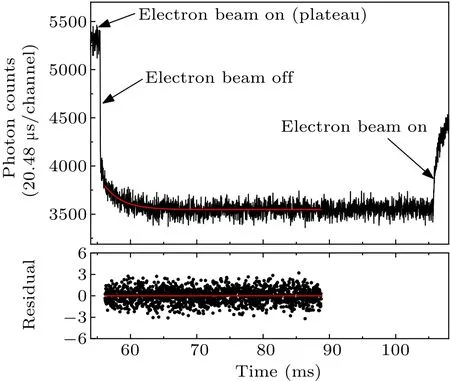
Fig.2.Experimental decay curve of the 3d92D3/2 level and residual from single exponential fit (bottom).The electron beam was turned off for 100 ms for fluorescence detection.The total data acquisition time was 68 h.
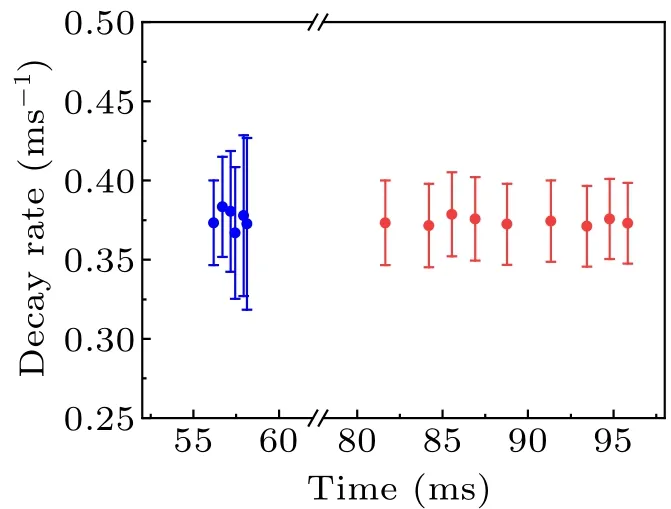
Fig.3.A series of fitting intervals are adopted to obtain the decay rates and check the reliability of the fitting results.Blue circles represent the decay rates obtained from various starting points with an ending point of 88.76 ms, while red circles denote the fitting results at different ending points with an initial point of 56.18 ms.
3.2.Systematic effects
In the determination of lifetimes through the fluorescence decay curve, systematic uncertainties can arise from various sources,[2,6,7,27]including ion losses by charge-exchange,possible cascade repopulation from high excited states, and the escape of ions out of the trap.In this section, we present a deep analysis of the systematics in our lifetime measurement of 3d92D3/2in Mo15+.
Charge exchange of the ions with neutral atoms of the residual gas could affect the charge-state distribution in the EBIT and therefore change the radiation decay curve.In order to control the growth of the Mo15+population caused by the charge exchange between higher ionized Mo ions and neutral atoms or lower charged ions, the electron energy was deliberately set below the ionization potential of Mo15+(591 eV[32,33]).This ensured that no higher charge state beyond Mo15+was created,and the resulting charge state distribution was examined by ion extraction and charge state distribution analysis.[20,34]Electron capture of Mo15+ions from background atoms resulted in an ion loss of Mo15+ions leading to a faster decay.The influence of the charge exchange effect could be suppressed by reducing the neutral number density which is related to the gas injection pressure.By tuning the injection pressure, we found charge exchange effect is negligible in the determination of lifetimes as long as the pressure is below 4×10-7torr.According to the empirical formula by M¨uller-Salzborn,[35,36]the single-electron chargeexchange cross-section was estimated to be 6×10-14cm2resulting in an ion loss rate of about 0.2 s-1.The chargeexchange effect was two orders of magnitude smaller than the statistical uncertainty of 26 s-1.
Cascade repopulation of the 3d92D3/2metastable level by transition from higher lying levels having ms lifetimes could in principle influence the measured decay curve.From this point of view,the 3d84s configuration might contribute to the slow electric-dipole forbidden transitions.The relativistic configuration interaction method encoded in the flexible atomic code[37]is employed to calculate the energy levels and transition probabilities among all the 16 levels belonging to 3d84s.All the metastable levels within 3d84s exhibit decay times less than 5μs.Repopulation of the 3d92D3/2level could occur over the first fewμs after turning off the electron beam.By starting the fitting procedure at 1 ms,the effect of cascade repopulation is essentially insignificant.
After turning off the electron beam,the ion cloud expand radially due to the sudden absence of the electrostatic potential generated by the space charge of the electron beam.Consequently,a large number of ions might escape out of the viewing region of the detection system.The decay curve (Fig.2)shows an initial steep falloff of the signal that extends over about 0.1 ms,indicating this fluorescence loss mechanism.In order to evaluate the effect of the ion cloud expansion,an adjustable slit was mounted between the lens and the ion cloud to narrow the viewing region.Our experimental setup permitted access to a viewing region of up to 18 mm in width.A series of studies using different slit widths(5 mm,10 mm,15 mm and 20 mm)were carried out.The steep falls occurred in all experimental settings,however,the fitted decay rates were consistent within the statistical error bars as soon as the start fitting point is selected to over 1 ms.In conclusion,the radial expansion of ion could take place in a very short time and it did not influence the determination of lifetime of 3d92D3/2in Mo15+as we simply excluded those ions in the analysis procedures.
In Fig.2,an asymmetry in the photon counts at the time when switching on and off the electron beam can be noticed.The reduced photon emissions after switching on the electron beam to re-excite the ions are mainly because of the reduction in the overlapping of the beam and the expanded ion cloud.[7,27]On the other hand, Mo15+ions are leaking out of the potential well in the magnetic trapping mode, which can also result in decrease of the photon counts.In order to investigate the potential ion loss mechanism,the beam-off time referring to the magnetic trapping time is changed from 2 ms to 600 ms to study the dependence of the decay photons from the re-excited ions.The measured decay curves with different magnetic trapping times are plotted in Fig.4.It can be seen that for shorter magnetic trapping time the photon count from the re-excited ions is more, indicating less loss of ions.The photon counts are recorded and plotted as different magnetic trapping time in Fig.5.A single exponential function is employed to fit the data and the resulting loss rate is 18.5(5.9)s-1.This loss rate due to the leaking of trapped ions can eventually modify the measured lifetime of 3d92D3/2in Mo15+.As a result,the corrected decay rate is determined to be 354 s-1with a systematic uncertainty of 5.9 s-1.
In addition to the systemic effects mentioned above, the dead time of the data acquisition system will lead to a loss in photon counting.The dead time is measured to be approximately tens of ns in the previous work.[2]The highest photon count rate (electron beam on) in this work is 1.5 kHz, and therefore, the dead time of the data acquisition system does little effect on the results.
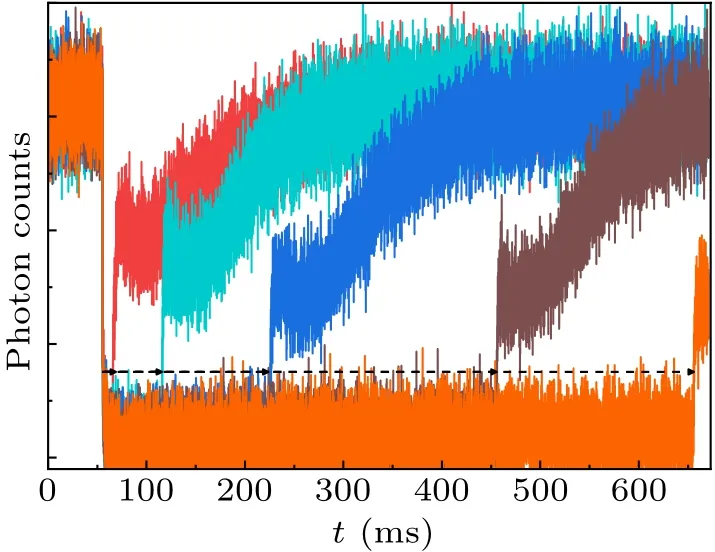
Fig.4.Decay curves obtained with different magnetic trapping times.The black arrows indicate the time when the electron beam is switched on.The longer the magnetic trapping time, the fewer photons are observed after turning on the electron beam to re-excite Mo15+ ions.
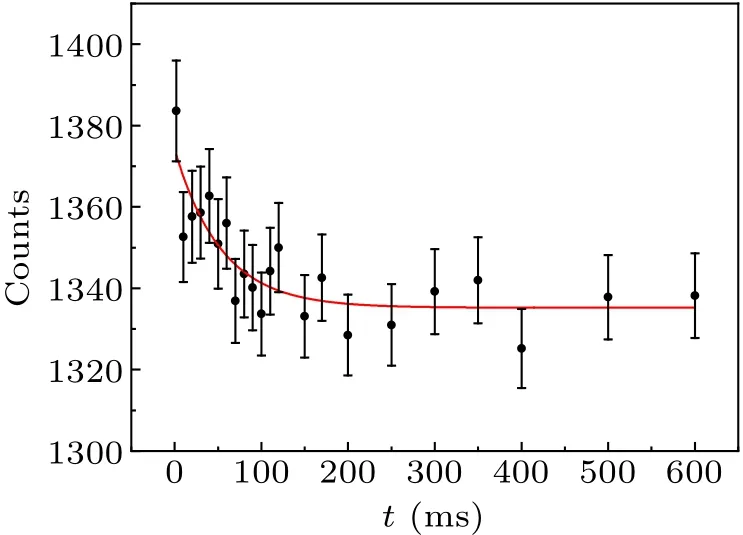
Fig.5.Ion losses on the different magnetic trapping times.The red solid line shows the single exponential function used to fit the data,and the loss rate was obtained to be 18.5(5.9)s-1.

Table 1.Lifetime of the Mo15+ 3d92D3/2 metastable level.Theoretical results from the relativistic Hartree-Fock self-consistent field(HFR) method, multiconfiguration Dirac-Hartree-Fock (MCDHF) approach, and relativistic coupled-cluster theory (RCC) method are presented.Notation a(±b)corresponds to a×10±b.
Based on the analysis of the statistic and systemic uncertainties in the measurement, the decay rate of the 3d92D3/2-2D5/2transition in Mo15+is determined to be 354(27) s-1,and the corresponding lifetime is 2.83(22) ms.In Table 1,the experimental value is compared with the existing theoretical calculations.According to the atomic structure theory,the 3d92D3/2level decays mainly through the spin-flipping M1 transition while the possibility of electric quadrupole(E2) transition is rather low.[23,38]The measured lifetime of 2.83(22) ms is consistent with the calculation using the relativistic coupled-cluster theory (RCC) method.[23]However, other calculations with the relativistic Hartree-Fock self-consistent field (HFR) method[38]and multiconfiguration Dirac-Hartree-Fock(MCDHF)approach[21]do not agree with our result.To address this ambiguity,more in-depth theoretical investigations are required.
4.Summary and outlook
We present a lifetime measurement of 3d92D3/2metastable level in Mo15+using an electron beam ion trap.The systematic uncertainties are comprehensively analyzed in this measurement,which allows for a precise determination of lifetime to be 2.83(22) ms.Our experimental result with an uncertainty of around 8% distinguishes between the existing theoretical calculations.
The dominant uncertainty stems from statistics considerations due to high background photons in the current measurement.To improve the signal-to-noise ratio and thus reduce the statistic uncertainty, techniques in suppressing the stray light from the hot electron gun cathode should be implemented.Recently,a new ion trap has under constructed to capture the excited ions from the EBIT.In this trap,the stray light from the hot cathode and the other systematic effect due to the ion cloud expansion during the electron beam cut-off can be eliminated.
Acknowledgments
Project supported by the National Key R&D Program of China(Grant No.2022YFA1602500)and the National Natural Science Foundation of China(Grant No.12274352).
- Chinese Physics B的其它文章
- Corrigendum to“Reactive oxygen species in plasma against E.coli cells survival rate”
- Dynamic decision and its complex dynamics analysis of low-carbon supply chain considering risk-aversion under carbon tax policy
- Fully relativistic many-body perturbation energies,transition properties,and lifetimes of lithium-like iron Fe XXIV
- Measurement of the relative neutron sensitivity curve of a LaBr3(Ce)scintillator based on the CSNS Back-n white neutron source
- Kinesin-microtubule interaction reveals the mechanism of kinesin-1 for discriminating the binding site on microtubule
- Multilevel optoelectronic hybrid memory based on N-doped Ge2Sb2Te5 film with low resistance drift and ultrafast speed

